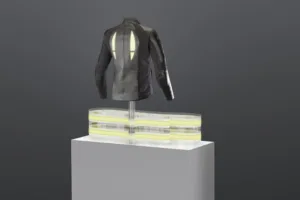Up to now, OLEDs have been used exclusively as a novel lighting technology for use in luminaires and lamps.
However, flexible organic technology can offer much more: as an active lighting surface, it can be combined with a wide variety of materials, not just to modify but to revolutionize the functionality and design of countless existing products. To exemplify this, the Fraunhofer Institute for Organic Electronics, Electron Beam and Plasma Technology FEP together with the company EMDE development of light GmbH will be presenting hybrid flexible organic light-emitting diode (OLEDs) integrated into textile designs within the EU-funded project PI-SCALE for the first time at LOPEC (March 19-21, 2019 in Munich, Germany) as examples of some of the many possible applications.
The Fraunhofer FEP, a provider of research and development services in the field of organic electronics, has long been involved in the development of technologies and processes for organic electronics and component integration. The team at the design company of EMDE development of light GmbH also has many years of experience with the new organic light-emitting diode light (OLED), including development of the world’s first OLED luminaire series. OLEDs cannot only emit colored and wide area light, but they themselves are also extremely low-profile and flexible, allowing them to be integrated into many types and shapes of surfaces. They can be even be designed to be transparent and dimmable. To demonstrate the sheer endless potential for employing OLEDs, the designers at EMDE are now integrating flexible OLEDs for the first time into a motorcycle jacket. Used as a material for clothing, OLEDs not only can trigger completely new aesthetic trends, they can also provide active illumination instead of just limited reflectance. This enhanced visibility from all angles means the wearer can be seen more clearly, increasing rider safety.
This is made possible by fabricating the OLEDs on flexible substrates such as plastic films and connecting them to conductive threading for their supply of electrical power. Together with the HOLST Center in Eindhoven, the Fraunhofer FEP in Dresden, Germany, has now for the first time implemented an extended approach of the technology for the OLED on the joint pilot line service LYTEUS within the EU-funded project PI-SCALE – a hybrid OLED.
Claudia Keibler-Willner, head of department at the Fraunhofer FEP, explains: “We have taken a major step forward in economical fabrication processes for OLEDs. The results are impressive: the OLED shines very uniformly. The use of the roll-to-roll process also promises considerable cost reductions for future components. By combining printed and vaporized layers, process throughput and production speed can be increased up to 100 times.”
Clear advantages for designers result – infinitely long materials with practically unrestricted dimensions and configurations can be created. The only limitation is the 30 cm roll width of the substrate material. Thomas Emde of EMDE development of light GmbH looks ahead: “We are very pleased to present a first design demonstrator using the hybrid OLEDs from the EU project PI-SCALE at LOPEC 2019. After examining the first samples, we decided on a prototype that would combine imagination with a practical application. We exhibit a few meters of the hybrid OLED in its raw form from the roll as a “pure” material component. Its transformation into a future product is illustrated through the example of our eyecatcher motorcycle jacket with luminous, integrated, flexible OLEDs. This will suggest the potential of OLEDs as an innovative surface material for interior design and product applications, fashion and textile designs, and architectural and signage uses.”
The Fraunhofer FEP and EMDE teams want to tackle challenges of fabrication and integration of OLEDs with different surfaces jointly in the future and are open to further development projects with industrial partners.
The exhibits can be seen during LOPEC 2019 in Munich, Germany from March 19-21, 2019 at Hall B0, booth no. 407 of the Fraunhofer FEP and the OE-A competition area. In addition, the aforementioned design demonstrator from EMDE as well as other design kits from Fraunhofer FEP have been submitted to this year’s OE-A Competition
About EMDE development of light GmbH
EMDE development of light GmbH was founded in 2015 by internationally renowned lighting artist Thomas Emde and specilizes in the conception, development, and manufacture of innovative lighting solutions and applications. Intensive involvement with applications in trend-setting OLED technology, development of newly conceived luminaires, and other advanced applications for OLED light together with careful attention to lighting effects characterize the company’s work. EMDE develops minimalist luminaires for its own OMLED brand based on the latest OLED technology, contributing significantly to technological development of OLED use. Augmenting that is research and development on new applications for functional lighting surfaces that will redefine the future of light. The focus is always on clean, simple, artistic lines, and on cutting-edge technical requirements, with the interdisciplinary team of designers and engineers following the principle of “less is more” when implementing technical solutions.
www.emdegmbh.com
Fraunhofer FEP and EMDE GmbH at LOPEC 2019
Booth No.: 407, Hall B0
Conference Talks and Poster
20 March 2019, 11:50 – 12:10, Session: Lighting, Room 13b
Jan Hesse, Fraunhofer FEP:
- Color-tunable OLED-lighting modules: Technology overview, design opportunities and applications
- Color-tunable OLED
- Color fading and flexible OLED
- Customized OLED
20 March 2019, 12:10 – 12:30, Session: Biomedical applications, Room 13a
Stephanie Schreiber, Fraunhofer FEP:
- Biodegradable organic thin film transistors
- Biodegradable organic thin film transistors
- Polyactic acid (PLA)
- Medical implants
20 March 2019, 18:00 – 19:30, Scientific Conference Poster, Session: Devices, ICM Foyer
Dr. Michael Törker and Claudia Keibler-Willner, Fraunhofer FEP:
- Spectral response of top illuminated organic photodetectors
- Top illuminated organic photodetector
- Bottom illuminated organic photodetector
- EQE, ZnPc, ClAlPc

